Gibraltar Class Carrier
(Version 1.01
- Last updated: 04/30/03)
- Background and RPG Statistics by
Kenneth Olson
Artwork from Wildstorm Comics "Robotech #0"
BACKGROUND
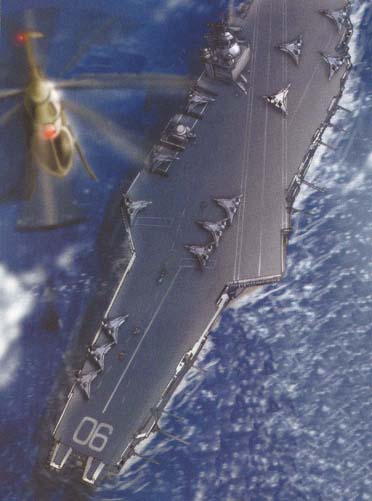 In the early
1990's, the United States Navy realized that a Global Conflict with the Eastern
Co-Prosperity Sphere (ECPS) forces was a real possibility. Control of the
sea-lanes would be of critical importance to allow the Western Alliance the
capability of shipping war material from the United States to its European and
Asian allies. As the current Nimitz class carriers, even under wartime
conditions, would take nearly four years to complete, a new design was necessary
to speed up the rate of carrier production to replace ships which would
inevitably be lost in combat. In an effort to save on production costs the
United States and Royal Navies entered into a joint program which would
take the best characteristics of the Nimitz class and place them on a new class
of carriers which could be massed produced.
In the early
1990's, the United States Navy realized that a Global Conflict with the Eastern
Co-Prosperity Sphere (ECPS) forces was a real possibility. Control of the
sea-lanes would be of critical importance to allow the Western Alliance the
capability of shipping war material from the United States to its European and
Asian allies. As the current Nimitz class carriers, even under wartime
conditions, would take nearly four years to complete, a new design was necessary
to speed up the rate of carrier production to replace ships which would
inevitably be lost in combat. In an effort to save on production costs the
United States and Royal Navies entered into a joint program which would
take the best characteristics of the Nimitz class and place them on a new class
of carriers which could be massed produced.
The resultant Gibraltar class carrier has the same basic hull, flight deck,
command tower, elevator, and catapult locations as the older Nimitz class
carriers; however, its modular design allows much of the fabrication of the ship
to be carried out off site. This same basic hull design allows the
Gibraltar class to carry one squadron of F-14 "Tomcats" and three squadrons of
F/A-18 "Hornets" along with numerous other electronic attack, airborne early
warning, and support aircraft (see ship's compliment).
The Gibraltar class does feature a new nuclear propulsion plant which leverages
from the previous three generations of shipborne nuclear technologies and is
rated for 50 years (or the lifetime of the ship) without the need for refueling.
In addition to the reactors a new electrical system was added to the Gibraltar
class of carriers. The newer system is completely redundant and will
require reduced maintenance over the previous generation.
The joint United States Royal Navy design was approved in July 1990 with
two sister ships laid down simultaneously, CVN-86 USS Langley in the Newport
News shipyards and the HMS Gibraltar by Vickers Shipbuilding in the UK.
Difficulties resulting in the construction of the Royal Navy's first nuclear
propelled carrier pushed the commissioning of the Gibraltar back nearly 12
months after the Langley. However, the design proved so successful that
other Western Alliance members, mainly France, expressed an interest in
obtaining the new carrier design. The technology was quickly transferred
to the DCN International Shipyard in Brest France and they began construction on
the Layette 14 months prior to the commencement of the Global Civil War.
As the prospect of a conflict with ECSP forces became evident the number of new
carriers laid increased at a feverish rate. Once the conflict broke out in
early 1995 the Western Alliance had four ships in commissioned with three under
construction in the US, one in the UK, and one in France. Throughout the
four year conflict, both the Nimitz and Gibraltar class carriers participated in
nearly every major battle with the ECSP forces. A total of 15 Gibraltar
carriers were produced during the war (10 for the US, 3 for UK, and 2 for
France) and 8 were lost during the course of the war. Of all of these
losses only CVN-95 Monterey and the R92 Lafayette were sunk as a result of
airborne attacks. The other six Gibraltar carriers were lost as a result
of torpedo or submarine launched cruise missiles.
Although the arrival of the SDF-1 did result in the destruction of one of the
most fabled carriers of the conflict the CVN-90 Kenosha when she was caught in a
seismic title wave, the arrival did bring about the end of the Global Civil War
and the formation of a new United Earth Government. Any new military
operations would occur mainly in space and as a result any earth bound surface
ships would be extremely vulnerable to bombardment from low orbit All of
the Gibraltar carriers under construction were scrapped to clear the way for the
next generation of Prometheus and Daedalus submersible carriers which were
currently under design.
When the United Nations Naval Force was created in 2001, five of the surviving
carriers were transferred to the new UN Navy where they continued to serve over
the next decade battling anti-unification forces around the world, but at no
time did they come under direct attack as they were positioned well away from
the front lines. All of that changed in April of 2011 when the Zentraedi
armada bombarded the planet destroying all but CVN-87 Intrepid and CVN-94
Oriskany.
During the reconstruction years, these carriers traveled around the oceans
providing stability to war wracked locations. Both of the surviving
carriers were sent on no less than 35 humanitarian missions over the next 5
years flying much needed food, water, and medical supplies to regions in need.
Although, the combat mission had decreased for the conventional super-carrier as
both the Daedalus and Prometheus class carriers were superior in all aspects,
both ships served as mobile bases for RDF forces in South American providing air
support for ground units.
Both carriers were transferred to the Armies of the Southern Cross with the
departure of the REF in December of 2022. The Intrepid was destroyed by
bioroid forces while protecting the UEG headquarters in Scandinavia at the end
of the 2nd Robotech War. The Oriskany and sole survivor of the
once proud class of super-carriers was finished off by the Invid during their
invasion of the planet in 2031.
RPG STATS
- Vehicle Type: Nuclear Propelled Aircraft Carrier
- Class: 2nd Generation Improved Nimitz Class
- Manufacturer: Newport News Shipbuilding (US), Liton
Ingalls Shipbuilding (US), Vickers
Shipbuilding and Engineering (UK), and DCN International (FRA)
Crew:
- Ship Compliment: 3160 Total (160 Officers and 2900 Enlisted)
- Marines: 72 total (2 Officers and 70 Enlisted)
- Air Wing: 2865 Total (365 Officers and 2,500 Enlisted)
- Service History:
- United States Navy from 1992 until 2005
- Royal Navy from 1994 until 2005
- Marine Nationale (French Navy) from 1996 until 1999
- Earth Defense Forces from 2005 until 2022
- Armies of the Southern Cross 2022 until 2031
US Navy Names and Dispositions
| Name |
Builder |
Commission |
Disposition |
| CVN-86 - Langley |
NNS |
31-Dec-1992 |
Destroyed during Zentraedi Rain of Death, Apr-2011 |
| CVN-87 - Intrepid |
LIS |
16-Aug-1993 |
Sunk off north sea at end of 2nd Robotech War, |
| CVN-88 - Franklin |
NNS |
31-Jan-1994 |
Destroyed during Zentraedi Rain of Death, Apr-2011 |
| CVN-89 - Randolph |
LIS |
9-Oct-1995 |
Sunk in Java Sea during Global Civil War, July 1997 |
| CVN-90 - Kenosha |
NNS |
12-Dec-1995 |
Destroyed near Macross Island when SDF-1 landed, July 1999 |
| CVN-91 - Hancock |
LIS |
15-Apr-1996 |
Sunk in Arabian Sea during Global Civil War, Nov 1998 |
| CVN-92 - Bennington |
NNS |
6-Aug-1997 |
Sunk in Japanese Sea during Global Civil War, Jan 1999 |
| CVN-93 - Kearsage |
LIS |
2-Mar-1998 |
Destroyed during Zentraedi Rain of Death, Apr-2011 |
| CVN-94 - Oriskany |
NNS |
3-Jan-1999 |
Sunk in pacific during Invid Invasion, |
| CVN-95 - Monterey |
LIS |
17-Mar-1999 |
Sunk in 2nd Battle of Philippine Sea during
Global Civil War, June 1999 |
| CVN-96 - Coral Sea |
NNS |
- |
Scrapped while 75% complete |
| CVN-97 - Shangri-La |
LIS |
- |
Scrapped while 55% complete |
| CVN-98 - Lexington |
NNS |
- |
Scrapped while 35% complete |
- NNS - Newport News Shipbuilding
- LIS - Liton Ingalls Shipbuilding
Royal Navy Names and Dispositions
| Name |
Builder |
Commission |
Disposition |
| R-101 - Gibraltar |
VSE |
16-Dec-1993 |
Sunk in North Sea during Global Civil War, Feb 1997 |
| R-102 - Vengeance |
VSE |
23-Feb-1995 |
Sunk in Mediterranean during Global Civil War, June 1998 |
| R-103 - Triumph |
VSE |
2-Oct-1998 |
Destroyed during Zentraedi Rain of Death, Apr-2011 |
| R-104 - Colossus |
VSE |
- |
Scrapped while 60% complete |
Marine Nationale Names and Dispositions
| Name |
Builder |
Commission |
Disposition |
| R92 - Lafayette |
DCN |
11-Apr-1996 |
Sunk in Mediterranean during Global Civil War, Feb 1997 |
| R93 - Richelieu |
DCN |
7-Jul-1998 |
Sunk in South Atlantic during Global Civil War, Mar 1998 |
MDC BY LOCATION:
| Location |
Gibraltar Class Carrier
|
| Main Elevators (4) |
300 each |
(1) Flight Deck
|
1,500
|
| (2) Command Tower |
1,300 |
| (3) Sensor Array |
250 |
| Hanger |
2,200 |
| (4) Main Body |
6,500 |
| (5) Propellers (4) |
200 each |
| Sea Sparrow Missile Launchers (3) |
75 each
|
| 20mm Phalanx (4) |
50 each |
| RIM-116 RAM (2) |
50 each |
| Hull & Deck (per 10 m2) |
100 |
| Interior Walls (per 10 m2) |
25 |
NOTES:
- Destroying the flight deck will prohibit any fixed wing air assets from
using the carrier; however, rotary assists can still land
- Destroying the command tower will kill most of the senior officers and
destroy the long range SPS-48(E) radar system
- Destroying the sensor array will knock out the SPS-48(E) long range
radar system; however, the command personnel are not killed
- Destruction of the main body will sink the carrier in 1D4 minutes
- Destroying all four propellers will leave the ship without any means of
propulsion
PROPULSION:
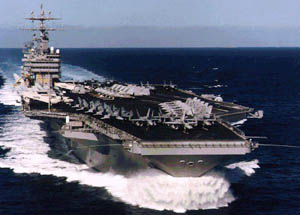 ENGINE:
ENGINE: - 4 steam geared turbines with four shafts, total of 280,000 shp
- REACTORS:
- 2 x General Electric A4W/A1G pressurized-water reactors
- ELECTRIC GENERATING POWER:
- 64,000 kW with an additional 8,000 kW emergency from four diesel engines
- MAX SPEED:
- 33 kts
- ENDURANCE:
- 10,000,000 miles with an estimated reactor life of over 50 years
STATISTICAL DATA:
- LENGTH:
- 335 m (overall / flight deck)
- 320 m (waterline)
- BEAM:
- 41 m (hull)
- 79 m (flight deck at maximum extent)
- DRAFT:
- 12.0 m
- HANGER DECK DIMENSIONS:
- 250 m x 40 m x 9.5 m
- WEIGHT:
- 78,500 tons (light)
- 102,250 tons (full)
- AIRWING:
- 1992-1994
-
- 12 x F-14(A/C/D) "Tomcat"
- 36 x F/A-18(A/C) "Hornet"
- 4 x E-2C "Hawkeye"
- 4 x EA-6B "Prowler"
- 7 x S-3B "Viking"
- 7 x SH-60F "Ocean Hawk"
- 1 x C-2A "Greyhound"
- 1994-2009
-
- 36 x F-203
"Dragon-II"
- 12 x LTV A-12 "Avenger II"
- 4 x E-2C "Hawkeye"
- 4 x EA-6B "Prowler"
- 7 x S-3B "Viking"
- 7 x SH-60F "Ocean Hawk"
- 2 x VC-33 "Mom's Kitchen"
- 2009-2022
-
- 24 x VF-1 "Valkyrie"
- 36 x
F-203 "Dragon-II"
- 4 x ES-11D "Cat's Eye"
- 7 x SH-303 "Sea Sergeant"
- 2 x VC-33 "Mom's Kitchen"
- 2022-2031
-
- 84 x
VF-8 "Logan"
- 4 x ES-11D "Cat's Eye"
- 7 x SH-303 "Sea Sergeant"
- 2 x VC-33 "Mom's Kitchen"
-
- AVIATION FUEL:
- 9,000 tons
- CATAPULTS:
- 4 x Steam C-13 Mod 1
- ELEVATORS:
- Two on starboard in front of the command
tower and one to the rear, one on the port side
-
WEAPON/DEFENSIVE SYSTEMS:
-
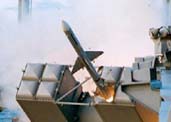 3 x NATO SEA SPARROW
(Mk 29) 8-TUBED LAUNCHERS: The Sea Sparrow naval version of the
AIM-7 Sparrow was developed in the late 1960s as an interim system for use
against Soviet anti-ship missiles. The missile was developed over the
next three decades leading up to the Global Civil War of the 1990's so that
it can now engage a variety of anti-ship cruise missiles and aircraft to
support ship defense.
3 x NATO SEA SPARROW
(Mk 29) 8-TUBED LAUNCHERS: The Sea Sparrow naval version of the
AIM-7 Sparrow was developed in the late 1960s as an interim system for use
against Soviet anti-ship missiles. The missile was developed over the
next three decades leading up to the Global Civil War of the 1990's so that
it can now engage a variety of anti-ship cruise missiles and aircraft to
support ship defense.
- PRIMARY PURPOSE: Anti-aircraft
- SECONDARY PURPOSE: Anti-Mecha
- RANGE: 14.8 km
- SPEED: Mach 2.5
- DAMAGE: 2D4*10 (high explosive rod) / 2D6*10 (high
explosive fragmentation) MDC
- BLAST RADIUS: 15 meters
- RATE OF FIRE: Up to 4 missiles per melee, one per
volley
- PAYLOAD: 8 missiles
- BONUS: +2 to strike
-
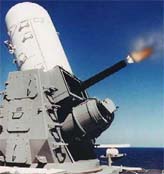 (1992-2009) 4 x
20MM MK 15 PHALANX (CIWS) : The Phalanx is the primary weapon system
which provides the carrier an automatic defense against anti-ship cruise
missiles and other airborne targets. The weapon fires a 12.75
depleted uranium at a rate of 4,500 rpm out to an effective combat range of
2,000 meters. The Phalanx can be used against surface targets by
using conventional optical target designators.
(1992-2009) 4 x
20MM MK 15 PHALANX (CIWS) : The Phalanx is the primary weapon system
which provides the carrier an automatic defense against anti-ship cruise
missiles and other airborne targets. The weapon fires a 12.75
depleted uranium at a rate of 4,500 rpm out to an effective combat range of
2,000 meters. The Phalanx can be used against surface targets by
using conventional optical target designators.
- PRIMARY PURPOSE: Anti-Missiles
- SECONDARY PURPOSE: Assault
- RANGE: 2,000 m
- DAMAGE: 5D6 MDC per short bursts (50 rounds)
- RATE OF FIRE: Up to 10 short bursts per melee
- PAYLOAD: 1,562 rounds
- BONUS: +2 to strike
 (1999-2009) 2 x
RIM-116 ROLLING AIRFRAME MISSILE (RAM): The Rolling Airframe
Missile (RAM) is a rapid-reaction, short-range, missile system for
shipboard defense using a modified AIM-9 "Sidewinder" missile with an IR
seeker from the Stinger SAM. In the initial flight phase, the missile
uses passive radio frequency homing on target emissions to point its IR
seeker at the target. During the terminal portion of the
flight, the guidance switches to IR if sufficient signal strength is coming
from the target otherwise the missile continues to guide towards the target
using the initial RF cue.
(1999-2009) 2 x
RIM-116 ROLLING AIRFRAME MISSILE (RAM): The Rolling Airframe
Missile (RAM) is a rapid-reaction, short-range, missile system for
shipboard defense using a modified AIM-9 "Sidewinder" missile with an IR
seeker from the Stinger SAM. In the initial flight phase, the missile
uses passive radio frequency homing on target emissions to point its IR
seeker at the target. During the terminal portion of the
flight, the guidance switches to IR if sufficient signal strength is coming
from the target otherwise the missile continues to guide towards the target
using the initial RF cue.
- PRIMARY PURPOSE: Anti-missile
- SECONDARY PURPOSE: Anti-aircraft
- RANGE: 20 km
- SPEED: Mach 2.5
- DAMAGE: 1D6*10 MDC
- BLAST RADIUS: 7 meters
- RATE OF FIRE: Up to 5 missiles per melee, one per
volley
- MISSILE PAYLOAD: 10 missiles per launcher
- BONUS: +3 to strike (IR) or +0 to strike (RF)
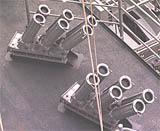 6 x LORAL
HYCOR MK 137 SUPER RAPID BLOOMING OFF BOARD CHAFF DISPENSER :
Six chaff dispensers are scattered around the carrier to provide protection
against RF homing missiles. Each dispenser consists of six tubes
filled with six packets of chaff deployed by the defensive systems
operator.
6 x LORAL
HYCOR MK 137 SUPER RAPID BLOOMING OFF BOARD CHAFF DISPENSER :
Six chaff dispensers are scattered around the carrier to provide protection
against RF homing missiles. Each dispenser consists of six tubes
filled with six packets of chaff deployed by the defensive systems
operator.
- PRIMARY PURPOSE: Anti-Missiles
- RANGE: 500 m
- RATE OF FIRE: Up to 6 packets per volley
- PAYLOAD: Six packets of chaff per tube for a total of
36 per launcher
- BONUS: Subtract -5 to strike from the missile attack roll
for every chaff/flare burst (-2 for intelligent missiles)
- 1 x
SLQ-32(V)4 ELECTRONIC WARFARE SUITE: Providing broadband
protection, the SQL-32 will inhibit enemy radars from detecting carrier,
identifies threats, and diverts missiles from hitting their target.
The system produces very high effective radiative power on inbound targets
minimizing their burn through range until they can no longer adjust their
flight path to hit the ship. However vehicles with ECCM systems will have
an easier time to located the system through passive direction finding
techniques.
- PRIMARY PURPOSE: Electronic Warfare
- SECONDARY PURPOSE: Anti-missile
- RANGE: 100 km
- BONUS SENSOR INSTRUMENTS: Subtract -10% from read
sensory instruments for every 10 kilometers within 100 kilometers
effective range of the system (eg at 60 kilometers subtract -40%).
ECCM systems are +25%.
- BONUS MISSILES: RF homing missiles are -5 to strike;
however anti-radiation missiles are +5 to strike
- 1 x
AN/ALQ-25 NIXIE TORPEDO COUNTERMEASURE: The Nixie is a passive,
electro-acoustic decoy system providing countermeasure against acoustic
homing torpedoes. The Nixie is towed from the rear of the carrier
with an onboard signal generation on the ship transmitting waveforms
through a fiber optic cable down to the decoy. The takes the incoming
signal from the inbound torpedo and magnifies it thereby presenting a more
appealing target than the ship. Once the decoy is deployed, the top
speed of the ship is reduced to less than 15 kts or the risk damaging the
decoy
- PRIMARY PURPOSE: Anti-torpedo
- RANGE: +25 km
- BONUS: -5 to strike with acoustic torpedoes
STANDARD EQUIPMENT FOR THE GIBRALTAR CARRIER:
- COMBAT COMPUTER: The combat computer tracks and identifies specific
enemy targets. The computer can identify and track up to 500 targets simultaneously.
- LIFE SUPPORT SYSTEMS: The ship under normal conditions carry
enough food for its crew for 90 days. Water is provided through four
distilling units with the capability of creating 400,000 gallons of fresh
water from sea water per day.
- HEAT AND RADIATION SHIELDS: Special shielding prevents the
penetration of life threatening radiation. A radiation detection and
alarm system are linked with the shields and will sound an alarm if there is a
rupture in the shields and what the levels of radiation are.
- LASER/RADIO COMMUNICATION: Long range, directional communications
system with satellite relay capabilities. Range: 600 miles (960 km) or can be
boosted indefinitely via satellite relay.
- RADAR (3D-SURVEILLANCE) ITT SPS-48(E): Long range S-Band pulse
Doppler providing detection at all altitudes with an estimated detection
radius against a 0 dBsm target out to 300 km. System consists of a
electronically scanned phased array antenna mounted on top of the command
tower.
- RADAR (2D-SURVEILLANCE) SPS-49(A): Long range L-Band radar
providing two dimensional air surveillance in the presence of severe
clutter and jamming environment. The system has an estimated detection
radius against a 0 dBsm target out to 300 km.
- RADAR (SURFACE SEARCH) SPS-67(V)1: Short range X-Band
two-dimensional radar providing highly accurate surface and low altitude
detection.
- RADAR (NAVIGATION) SPS-64(V)9: Short range X-Band
two-dimensional radar providing a high degree of target resolution for
accurate detection. Maximum detection range of 150 km
- RADAR WARNING RECEIVER ZTR-2 (RWR): Providing all aspect
broadband protection from RF guided missiles.
Random Hit Locations
When there is an equal chance of hitting both sides from 1D6
- 1-3 hits the right side
- 4-6 hits the left
When there is a preferred side, roll 1D10
- 1-8 hits the preferred side
- 9-10 hits the opposite side
| Gibraltar Class Carrier |
FRONT
|
BACK
|
SIDES
|
TOP
|
BOTTOM
|
| Main Elevators (Hanger) |
01-05 |
01-05 |
01-05 |
01-10 |
01-05 |
| Flight Deck (Main Body) |
06-20 |
06-20 |
06-20 |
11-65 |
06-10 |
| Command Tower
(Main Body) |
21-50 |
21-50 |
21-40 |
66-80 |
- |
| Sensor Array (Command Tower) |
51-55 |
51-55 |
41-45 |
81-90 |
- |
| Hanger (Main Body) |
56-65 |
56-65 |
46-60 |
- |
11-25 |
| Main Body |
66-90 |
66-85 |
61-90 |
- |
26-95 |
| Propellers (Main
Body) |
- |
86-90 |
91 |
- |
96-00 |
| Sea Sparrow (Flight Deck) |
91-93 |
91-93 |
92-94 |
91-93 |
- |
| Phalanx (Flight Deck / Command Tower) |
94-97 |
94-97 |
95-97 |
94-97 |
- |
| RIM-117 RAM (Flight Deck) |
98-00 |
98-00 |
98-00 |
98-00 |
- |
REFERENCES USED IN THIS DESIGN
- FAS.ORG: CVN-68 Nimitz class carrier
- Jane's: Nimitz class carrier
- Periscope.com: CVN-68 Nimitz class carrier
- UN SPACY Database: Theodore Roosevelt class carrier
- Warships1.com: Nimitz and Improved Nimitz class carrier
Back to Mecha Home
 In the early
1990's, the United States Navy realized that a Global Conflict with the Eastern
Co-Prosperity Sphere (ECPS) forces was a real possibility. Control of the
sea-lanes would be of critical importance to allow the Western Alliance the
capability of shipping war material from the United States to its European and
Asian allies. As the current Nimitz class carriers, even under wartime
conditions, would take nearly four years to complete, a new design was necessary
to speed up the rate of carrier production to replace ships which would
inevitably be lost in combat. In an effort to save on production costs the
United States and Royal Navies entered into a joint program which would
take the best characteristics of the Nimitz class and place them on a new class
of carriers which could be massed produced.
In the early
1990's, the United States Navy realized that a Global Conflict with the Eastern
Co-Prosperity Sphere (ECPS) forces was a real possibility. Control of the
sea-lanes would be of critical importance to allow the Western Alliance the
capability of shipping war material from the United States to its European and
Asian allies. As the current Nimitz class carriers, even under wartime
conditions, would take nearly four years to complete, a new design was necessary
to speed up the rate of carrier production to replace ships which would
inevitably be lost in combat. In an effort to save on production costs the
United States and Royal Navies entered into a joint program which would
take the best characteristics of the Nimitz class and place them on a new class
of carriers which could be massed produced. ENGINE:
ENGINE:  3 x NATO SEA SPARROW
(Mk 29) 8-TUBED LAUNCHERS: The Sea Sparrow naval version of the
AIM-7 Sparrow was developed in the late 1960s as an interim system for use
against Soviet anti-ship missiles. The missile was developed over the
next three decades leading up to the Global Civil War of the 1990's so that
it can now engage a variety of anti-ship cruise missiles and aircraft to
support ship defense.
3 x NATO SEA SPARROW
(Mk 29) 8-TUBED LAUNCHERS: The Sea Sparrow naval version of the
AIM-7 Sparrow was developed in the late 1960s as an interim system for use
against Soviet anti-ship missiles. The missile was developed over the
next three decades leading up to the Global Civil War of the 1990's so that
it can now engage a variety of anti-ship cruise missiles and aircraft to
support ship defense.
 (1992-2009) 4 x
20MM MK 15 PHALANX (CIWS) : The Phalanx is the primary weapon system
which provides the carrier an automatic defense against anti-ship cruise
missiles and other airborne targets. The weapon fires a 12.75
depleted uranium at a rate of 4,500 rpm out to an effective combat range of
2,000 meters. The Phalanx can be used against surface targets by
using conventional optical target designators.
(1992-2009) 4 x
20MM MK 15 PHALANX (CIWS) : The Phalanx is the primary weapon system
which provides the carrier an automatic defense against anti-ship cruise
missiles and other airborne targets. The weapon fires a 12.75
depleted uranium at a rate of 4,500 rpm out to an effective combat range of
2,000 meters. The Phalanx can be used against surface targets by
using conventional optical target designators. (1999-2009) 2 x
RIM-116 ROLLING AIRFRAME MISSILE (RAM): The Rolling Airframe
Missile (RAM) is a rapid-reaction, short-range, missile system for
shipboard defense using a modified AIM-9 "Sidewinder" missile with an IR
seeker from the Stinger SAM. In the initial flight phase, the missile
uses passive radio frequency homing on target emissions to point its IR
seeker at the target. During the terminal portion of the
flight, the guidance switches to IR if sufficient signal strength is coming
from the target otherwise the missile continues to guide towards the target
using the initial RF cue.
(1999-2009) 2 x
RIM-116 ROLLING AIRFRAME MISSILE (RAM): The Rolling Airframe
Missile (RAM) is a rapid-reaction, short-range, missile system for
shipboard defense using a modified AIM-9 "Sidewinder" missile with an IR
seeker from the Stinger SAM. In the initial flight phase, the missile
uses passive radio frequency homing on target emissions to point its IR
seeker at the target. During the terminal portion of the
flight, the guidance switches to IR if sufficient signal strength is coming
from the target otherwise the missile continues to guide towards the target
using the initial RF cue. 6 x LORAL
HYCOR MK 137 SUPER RAPID BLOOMING OFF BOARD CHAFF DISPENSER :
Six chaff dispensers are scattered around the carrier to provide protection
against RF homing missiles. Each dispenser consists of six tubes
filled with six packets of chaff deployed by the defensive systems
operator.
6 x LORAL
HYCOR MK 137 SUPER RAPID BLOOMING OFF BOARD CHAFF DISPENSER :
Six chaff dispensers are scattered around the carrier to provide protection
against RF homing missiles. Each dispenser consists of six tubes
filled with six packets of chaff deployed by the defensive systems
operator.